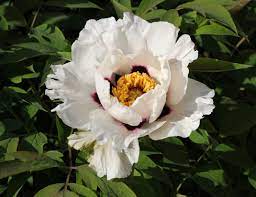 If I had the means and motivation to annex my neighbor’s property, I would create a garden room devoted to peonies of all sorts. In my mind’s eye, the scene unfolds, with hundreds of garden peonies, otherwise known as Paeonia lactiflora, in bloom. Tree peonies—Paeonia suffuticosa–would abound. Intersectional types, a marriage of tree and garden species, would flaunt their beautiful colors in the sunny corners. The species peonies of my dreams, including the alluring yellow-flowered Paeonia mlokosewitschii, aka “Molly the Witch,” would open their petals wide.
If I had the means and motivation to annex my neighbor’s property, I would create a garden room devoted to peonies of all sorts. In my mind’s eye, the scene unfolds, with hundreds of garden peonies, otherwise known as Paeonia lactiflora, in bloom. Tree peonies—Paeonia suffuticosa–would abound. Intersectional types, a marriage of tree and garden species, would flaunt their beautiful colors in the sunny corners. The species peonies of my dreams, including the alluring yellow-flowered Paeonia mlokosewitschii, aka “Molly the Witch,” would open their petals wide.
No peony garden, imaginary or actual, would be complete without ‘Joseph Rock,’ a stunning plant with a stolid name. I have had designs on it even longer than I have coveted my neighbor’s back forty.
‘Joseph Rock’ is a strapping peony, growing up to seven feet tall and wide, with blue-green leaves. A mature specimen might bear scores of fragrant flowers, each one up to eight inches wide. The petals are creamy white, pleated like Fortuny silk and melded together into a bowl-shaped bloom. Each one has a star-shaped dark purple splotch in the middle that frames a boss of golden stamens.
Tree peonies in general and ‘Joseph Rock’ in particular, are native to China, where they have been cultivated for centuries. ‘Joseph’ was probably first sighted in 1914 in China’s Gansu province by a legendary English plant collector, Reginald Farrar. He mostly likely brought back a specimen, which languished in the herbarium of the Royal Botanic Garden in Edinburgh until it was rediscovered and traced back to Farrar in 1990.
Fortunately for the world of peony lovers, a German-born, naturalized American scientist and plant hunter named Joseph Rock saw the tall white peony again in 1925. It was one of the 20,000 specimens that he sent back to Harvard University’s Arnold Arboretum, which then shared seeds with institutions in many locations. Botanical garden personnel and plant collectors fell in love with the statuesque peony, which was ultimately named after Rock. It has been in cultivation ever since.
‘Joseph Rock’ has just one little flaw. Traditionally it has been considered difficult to propagate, making it too expensive for mass retail distribution. The seeds can take two or even three years to germinate and then, of course, the plant has to reach blooming size, entailing more waiting time. A note on the website of the Royal Horticultural Society’s garden at Rosemoor mentions that modern micro-propagation methods have made ‘Joseph Rock’ less expensive to produce. Those of us scheming to annex a neighbor’s property, while simultaneously saving the funds necessary to afford ‘Joseph’, can now also dream of the day when the cost of one plant will go below one hundred dollars.
‘Joseph Rock’ does not demand much of the gardener. The plants need rich, well-drained soil and full sun to very light shade. Consistent moisture delivered by way of drip irrigation or soaker hoses is a plus. Peonies generally fare best in locations that are protected from wind and the worst of the weather. Under the right circumstances, they will live many, many decades.
Unfortunately, local authorities tend to frown on people who exercise a personal right of eminent domain and arbitrarily annex neighboring properties. Besides, I like my neighbor. Therefore, I have to come up with a “plan B” for ‘Joseph Rock.’
My suburban garden is already chock full of plants of all sizes and types and accommodating a seven by seven foot sun lover will be a challenge. Still, every year there are some plants that don’t survive the winter and others just begging to be relocated in the name of the eternal pursuit of garden perfection. The right site for ‘Joseph’ will present itself, possibly in time for the arrival of the tax refund. The plan has already come together in my mind. With enough plotting, scheme concocting and penny pinching, it will undoubtedly come together in my garden as well.
